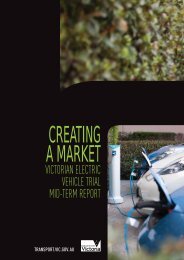Security Risk Assessment for Transport Operators - Department of ...
Security Risk Assessment for Transport Operators - Department of ...
Security Risk Assessment for Transport Operators - Department of ...
- No tags were found...
Create successful ePaper yourself
Turn your PDF publications into a flip-book with our unique Google optimized e-Paper software.
2.1 Introduction to risk analysisOptional advanced technique:Undertaking vulnerability andcriticality assessments (outlined inAppendix A ‘Further Techniques’,page 30), may help you get a betterunderstanding <strong>of</strong> the effectiveness<strong>of</strong> current controls that are in placeto protect an asset.Once you have identified the risks to your organisation, the next stage <strong>of</strong> the assessment processis to work out the level <strong>of</strong> risk (or ‘risk rating’) attached to each. By carrying out this analysis, youwill be in a better position to identify the risks that are <strong>of</strong> a higher priority to the organisation.To establish the level <strong>of</strong> risk, the following <strong>for</strong>mula is used:The level <strong>of</strong> risk is determined by rating the potential consequences<strong>of</strong> the risk occurring and its likelihood.The analysis process is completed in three stages to establish levels <strong>of</strong> consequence, likelihoodand risk. The tables included throughout this document should only be used as a guide andwhere possible, should be tailored to reflect your individual requirements.2.2 Consequence2.2.1 Rating consequenceYou must now rate each identified risk in terms <strong>of</strong> its potential consequences (should it occur),considering a number <strong>of</strong> key points:• The most plausible worst case scenario should be taken into account.• A single risk may have multiple consequence categories.• When analysing the potential consequences, you should take into consideration the measuresthat are currently in place to protect the asset (known as ‘current controls’).2.2.2 Consequence categoriesThe categories below and in the table on the next page, represent those that are <strong>of</strong>ten usedby transport operators in determining the consequences <strong>of</strong> a particular risk. These categoriesare intended as a guide and you should look to use (and develop) categories which suityour circumstances.<strong>Security</strong> <strong>Risk</strong> <strong>Assessment</strong> Guide 15
















